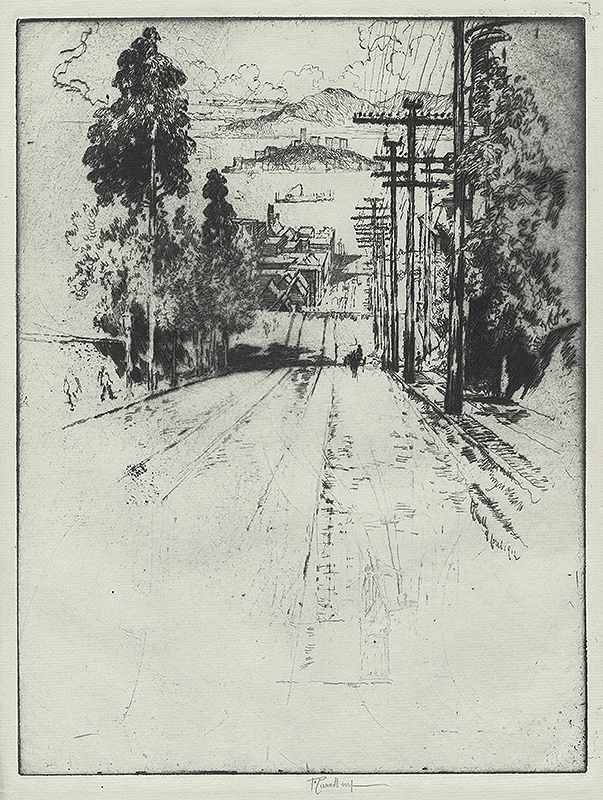Down to the Bay – from Stevenson’s House is an etching created in 1912 by American master printmaker, Joseph Pennell. It is pencil signed and inscribed imp in the lower center margin. It was printed by the artist on grey-green laid paper with a VO watermark. While uninscribed, the edition is thought to be around forty impressions. The references are Wuerth 643, Library of Congress 623, and PPIE 6963. An impression of Down to the Bay – from Stevenson’s House was featured in the Panama Pacific International Exposition in 1915. The paper is marked by several inky fingerprints and the platemark measures 12-3/8 x 9-1/16 inches.
Down to the Bay – from Stevenson’s House is the fourteenth of nineteen etchings Pennell created of San Francisco in 1912. This is a view down Hyde Street and in the distance is San Francisco Bay, the marina, and Alcatraz island, which at that time was a military prison. Writer Robert Louis Stevenson’s widow lived in a mansion designed for her by architect Willis Polk at the top of Russian Hill. It overlooked both Alcatraz and later, of course, Treasure Island. At the bay, Hyde Street is now the terminus for the cable car line. The tracks for the cars can be seen in this etching, running down the street.
Joseph Pennell was born on 4 July 1857 to Quaker parents in Philadelphia. He studied at the Pennsylvania Academy of Fine Arts and the Pennsylvania School of Industrial Art. Considered by many to be the dean of American printmaking, Pennell was a lithographer, etcher, author, educator, lecturer, and illustrator.
By 1882, Pennell was illustrating for Scribner's Magazine and The Century and received a commission for illustrating a book on Tuscany. In 1884 he traveled to Europe and settled in London where he produced numerous books, both as an author and as an illustrator, many of them in collaboration with his wife, author Elizabeth Robins Pennell. In 1912, Pennell left London for Panama where he created a series of lithographs rendering the construction of the Panama Canal. He voyaged via steamer along the Pacific Coast to San Francisco where he created numerous etchings of the city by the bay and, while there, influenced the founding of the California Society of Etchers.
In 1915, Pennell chaired the jury for etchings and engravings for the Panama-Pacific International Exposition where over 2,200 prints were exhibited and an entire gallery was devoted to his work. Pennell was a member of numerous organizations, including the Society of Painter-Etchers in London and was first president of the Senefelder Club. His tutelage of artists and scholars continue with his books Etchers and Etching and Lithography and Lithographers, and the bequest of his collection of prints and drawings to the Library of Congress.
Pennell produced more than 900 etchings and mezzotints and more than 600 lithographs on architectural and landscape subjects. He distinguished himself as one of America’s most talented etchers as well as a promotional genius who helped spur the revival of printmaking and print collecting during the first two decades of the 20th century.
Joseph Pennell died in Brooklyn Heights, New York on April 23, 1926.



